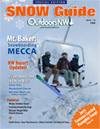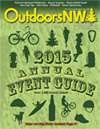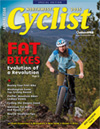Winter: Avalanches
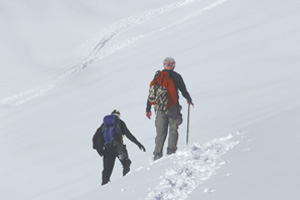
Understanding avalanches and how to avoid them
By Karen Sykes
Snow is beautiful but it can also be deadly. Anyone who skis, snowboards or snowshoes needs an understanding of avalanches and how to avoid potential hazards in winter.
Avalanches occur when of layers of snow release on a slope as each snowfall will layer on top of the preceding snowfall. If temperatures remain constant (unlikely), the snow layers bond to form a more solid mass, possibly even ice.
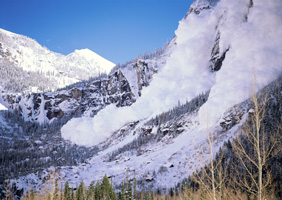
Top: Mountain climbers cross a snow field. Photo by Karen Sykes. Above: Twin avalanches roar down a mountain.
Enough of this and the long-term result can become a glacier or permanent snowfield. Changing temperatures affect the consistency of the layers of snow, creating effects such as layers of snow alternating with a layer of ice.
Assess an area first to see if it is avalanche-prone. If you dig a pit in the snow you can actually see the different layers of snow and ice. Tap the top layer; see if it slides (an old-school technique still used by some for assessing snow’s tendency to slide). Snow is most apt to slide on a sufficiently steep slope (commonly between 30 and 45 degrees). Use caution: It’s recommended you take a class to learn proper techniques of digging a snow pit.
One of the best resources for in-depth information about local avalanche conditions is the Northwest Weather and Avalanche Center (NWAC). Helpful handouts are also provided by national park visitor’s centers — Mount Rainier National Park’s handouts on avalanche awareness, for example, are informative without scaring visitors away.
Avalanche recognition
Avalanches can be triggered by too much snow falling too fast (snow falling an inch per hour or more, for example). They can also be caused by the following factors:
Rapidly changing temperatures
Snow that thaws then re-freezes
Water-saturated snow caused by rain or snow-melt
Rockfall
People traveling across open slopes that lack natural “anchors” for the snow, such as trees or rocks.
Snow pack instability
On-site evaluation of snow is important — learn to recognize signs of instability such as cracks, “do-nuts” (resembling do-nuts or pinwheels that roll down a slope), and lack of “anchors”— such as rocks or trees — on a steep slope.
Know your route
Whether you are skiing, snowshoeing, snowboarding or hiking in snow, know how steep the slopes are along your route — check both above and below your intended path. An inclinometer or clinometer is a handy tool that measures slope angle. Check to see if there are cornices. A cornice looks like a frozen wave hanging over the lip of a hill or ridge crest. These can break off from wind, precipitation, and even the stress of someone walking out onto one unaware they are standing on a cornice. An experienced Northwest skier and climber recently died when the cornice he was inadvertently standing on gave way.
When things go wrong
You can do everything right and still get caught in an avalanche. But you can lessen the risk of injury or death by following a few simple rules.
Never go out alone. A lone person caught by a serious slide will have virtually zero chance of survival.
If you become aware of a slide, start shedding your gear and head as fast as possible to the nearest edge of the slide.
If caught, start “swimming” through it—this is critical since it helps create an air pocket around you. Once snow stops moving it hardens into a nearly concrete configuration.
If buried, put your hands in front of your face allowing a space for air to form; try not to panic.
Don’t rely on your cell phone. Mountain areas usually have scanty cell phone coverage. If a member of your party is caught and you can’t locate them, send two members of your group for help (never one if you can help it). Search and rescue teams will come as quickly as they can but the process may take hours.
Before you go
Always check snow conditions with the Northwest Avalanche Center (NWAC), national parks and the Forest Service before setting out and check an up-to-date weather forecast.
Know your terrain: how steep are the slopes along your path of travel? Select routes with snow anchors such as trees and rocks. Study the map.
Avalanche safety gear
Traction devices that slip over shoes or crampons allow one to cross icy surfaces.
Ice axes are good for steep terrain but require training for proper use.
Trekking poles, or ski poles, are useful for cross country skiing or snowshoeing for help with stability.
Metal shovel (at least one per party) for digging out an avalanche victim or for building an emergency snow-cave.
Probes are essential for seeking a buried person in the snow.
Avalanche transceivers: Carry, practice and know how to operate avalanche transceivers (akin to short range radios) before setting out. Each member must carry one for this system to work and that will take practice.
Avalanche danger rating system (From NWAC)
Low: Snow travel is usually safe
Moderate: Slab and human-caused avalanches are possible
Considerable: Chances of natural and human-triggered avalanches increase. Exercise caution in steep terrain.
High: Natural and human-caused avalanches are likely—travel not recommended.
Extreme: Destructive avalanches likely, travel not recommended. If you must travel avoid steep terrain, and travel on low-angle terrain far from avalanche run-out (slide chutes).
Types of Avalanches
Sluffs: small avalanches
Climax avalanches: large and destructive
Loose snow avalanches: less consolidated snow
Slab avalanches: when a layer of snow slides on an older, weaker layer of snow. (This is the most common type of avalanche.)
Resources
NWAC Northwest Avalanche Center: www.nwac.us/forecast/weather/current/
West Coast Weather: www.westcoastweather.com
SNOTEL: www.wcc.nrcs.usda.gov/snow/
The ABC’s of Avalanche Safety by Sue A. Ferguson and Edward R. LaChapelle, (Mountaineer Books): www.mountaineersbooks.org/
National Snow and Ice Data Center: www.insidc.org
American Avalanche Center: www.americanavalancheassociation.org
Mountain Rescue Association: www.mra.org
National Ski Patrol: www.nsp.org
National Weather Service: www.nws.noaa.gov
Turns All Year: www.turns-all-year.com/
Avalanche Awareness Classes
American Institute for Avalanche Research and Education (AIARE): www.avtraining.org
American Alpine Institute: www.aai.cc
Cascade Powder Cats: www.cascadepowdercats.com
Mountain Madness: www.mountainmadness.com
North Cascades Mountain Guides: www.mountainschool.com
Oregon Avalanche Institute: www.oravalanche.org
Payette Powder Guides (Idaho): www.payettepowderguides.com

